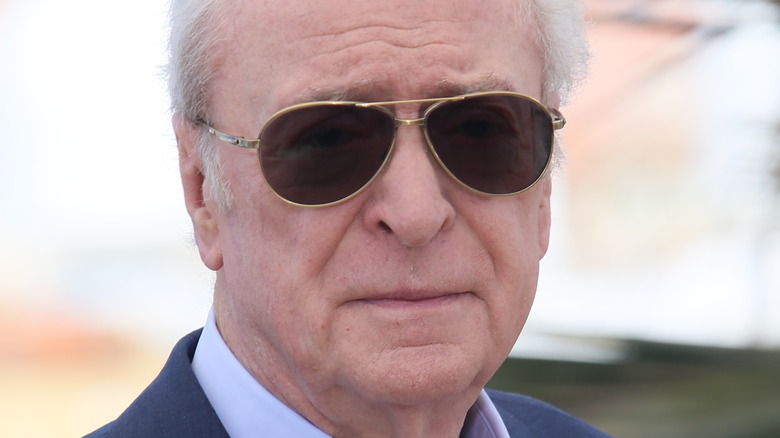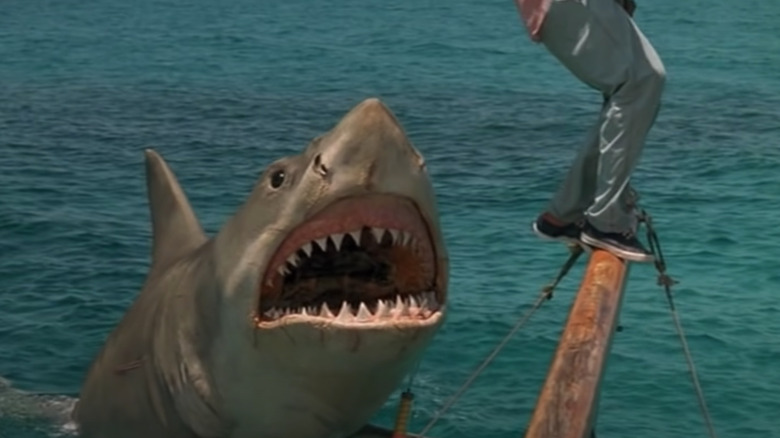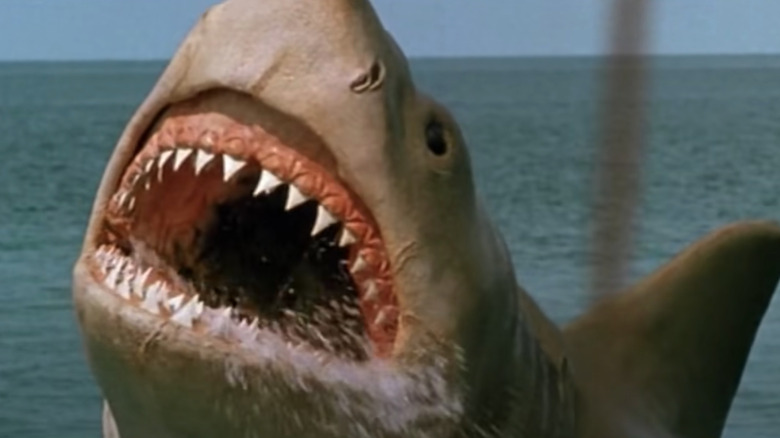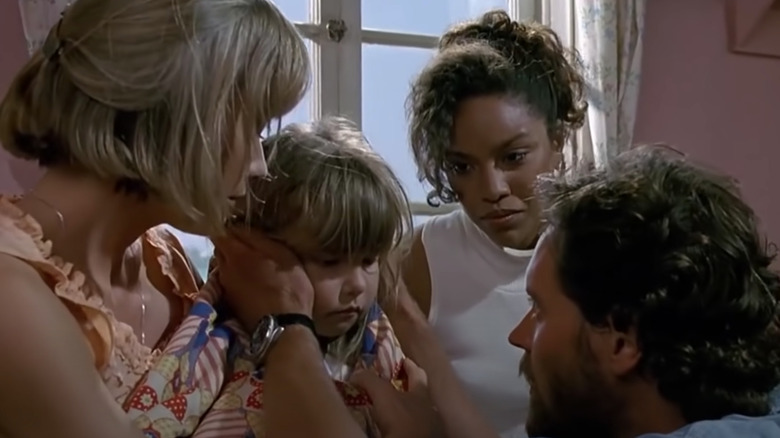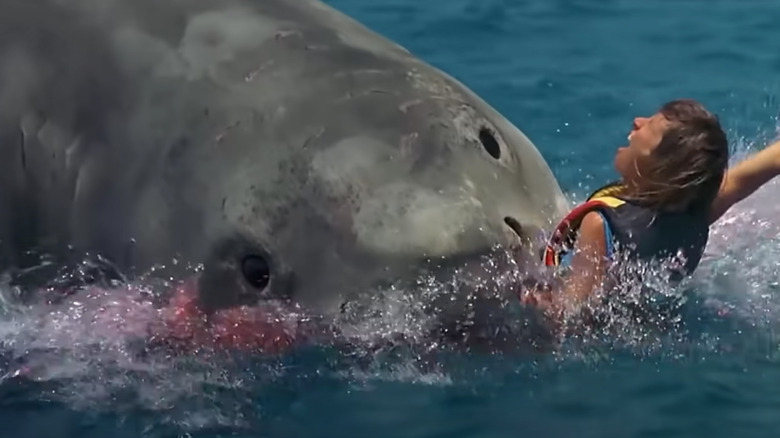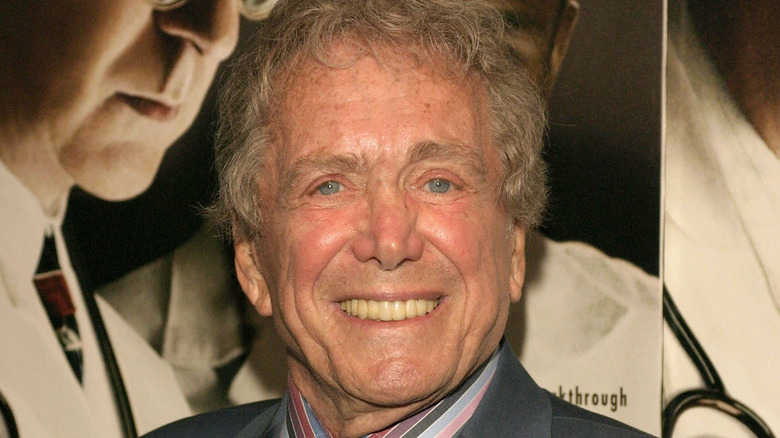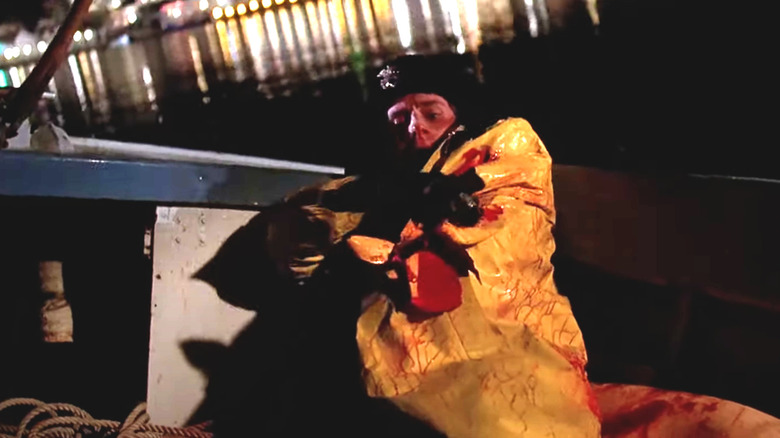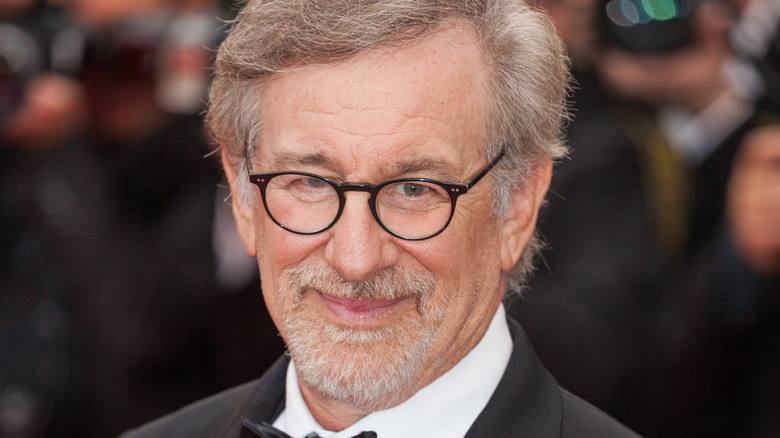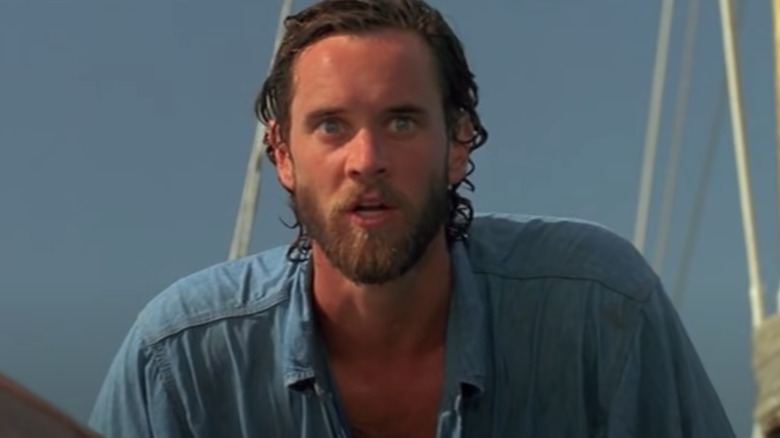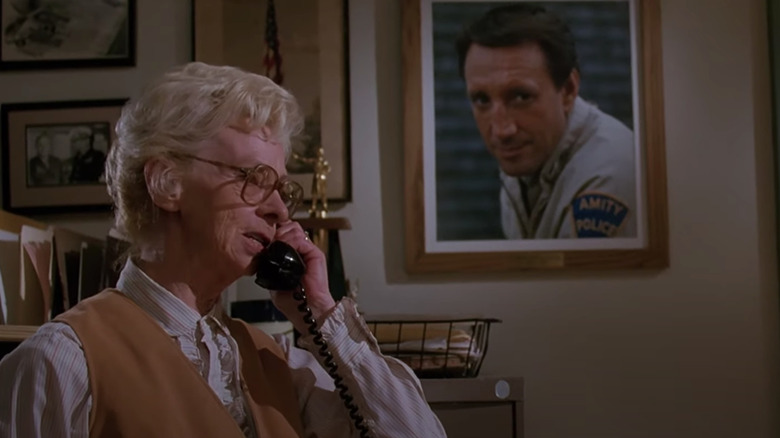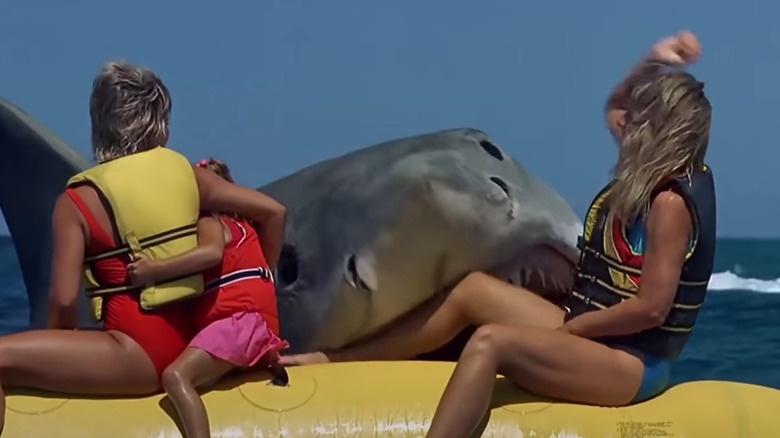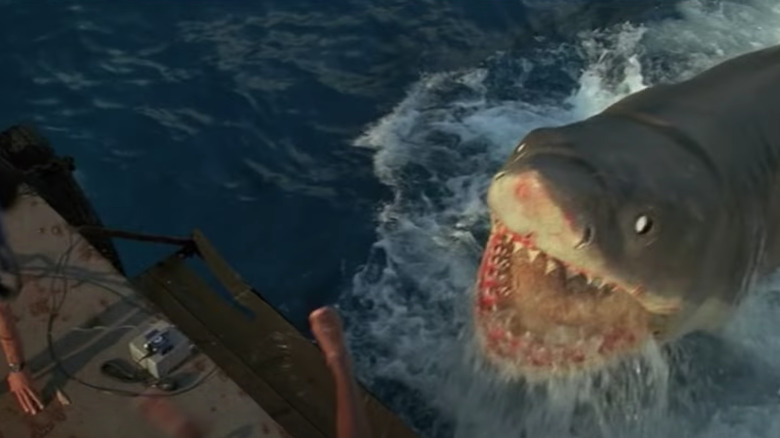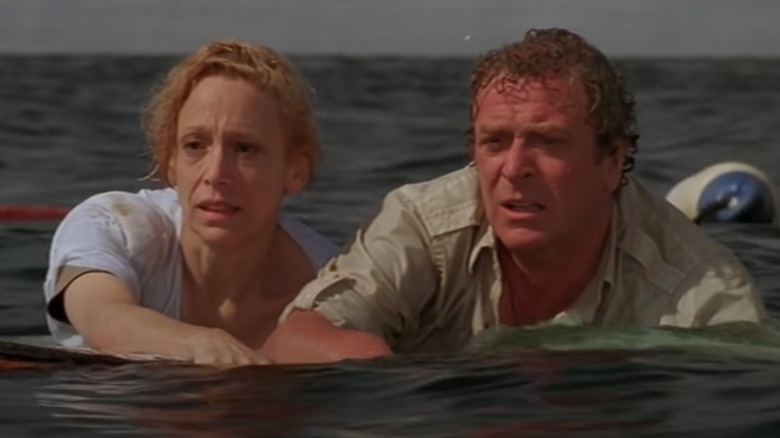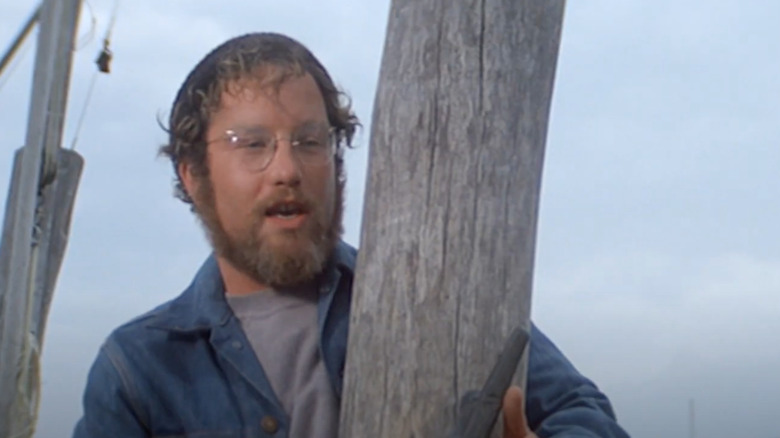Take A Bite Out Of These Jaws: The Revenge Stories
Calling Steven Spielberg's "Jaws" a classic somehow feels like an understatement. The 1975 shocker about an island community under siege by a killer great white shark remains one of the most entertaining and well-crafted motion pictures ever made, and launched the careers of many involved, including the 26-year-old Spielberg. It's captivating, thrilling, terrifying, funny, emotional, and absolutely enthralling.
On the other hand, "Jaws: The Revenge," the fourth and final film in the franchise, resides on the opposite end of the critical spectrum. To put it mildly, the fourth entry in the shark franchise is awful, and easily one of the worst films ever made. In fact, "Jaws 4" is so bad, it's actually quite great.
Directed by Joseph Sargent, and featuring a cast that includes Lorraine Gary, Lance Guest, Mario Van Peebles and (remarkably) Michael Caine, "Jaws: The Revenge" tried to take the series back to its roots following the disappointing box office of "Jaws 3-D," and only succeeded in driving the lucrative franchise into the ground for good.
What went wrong? How did a film with so much promise wind up so laughably bad? Worry not, because we're here to give you all the sordid, crazy, and weird stories behind "Jaws: The Revenge."
Someone fixed the special effects
One of the biggest issues with "Jaws: The Revenge" lies in its iteration of Bruce the shark. Despite a fairly decent $23 million production budget and the benefit of three previous films to learn from, the mechanical monster somehow looks worse than its predecessors. The film's action sequences, no matter how well executed, lack suspense because you're too busy laughing at the giant rubber fish stalking our heroes.
To get a peek at what might have been, check out this incredible video (via JoBlo) pieced together by Steve Clarke and his team at CKVfx, which updates the visuals of a key action sequence in "Jaws: The Revenge" to great effect. Dare we say, the results are actually quite thrilling? So much so that we wish Steve and his team would give the entire film a complete makeover — maybe enhanced digital effects would be enough to distract us from the awful performances, writing and dialogue.
Eh, probably not. But critics and audiences might have been a little more forgiving if the movie's monster had been more convincing. Maybe.
There are at least two different endings
If you happened to be one of about 20 people on the planet who saw "Jaws: The Revenge" twice, chances are you were privy to a different version of the film. See, when Universal unveiled its fourth entry in the popular franchise in summer 1987, audiences were unhappy with (among many things) an ending that saw 1) Bruce IV devour poor Mario Van Peebles and 2) Bruce IV's ridiculous death-by-bowspit.
According to Paul Downey's book, "The Shark is Roaring – The Story of Jaws: The Revenge" – which offers a comprehensive look at the film's troubled production — Universal was displeased with the finale and ordered reshoots after the film had already been released in theaters. The new version, shown to international audiences, features Peebles' character somehow surviving his ordeal with Bruce IV and includes a dramatic new demise for our sharp-toothed baddie, which goes as follows: after colliding with "Neptune's Folly," the ship Mrs. Brody commandeers during the climax, the shark, um, explodes. It's never stated how or why the shark explodes. It just does.
What's more, the powers-that-be swapped out giant mechanical Bruce IV for an extremely cheesy miniature and ... well, you can see the results here.
The cast is actually pretty great
Surprisingly, the cast of "Jaws: The Revenge" is pretty great. Along with returning star Lorraine Gary, the ensemble includes Lance Guest from "The Last Starfighter," director-actor Mario Van Peebles (who would, coincidentally enough, go on to direct "USS Indianapolis: Men of Courage," or Quint's story from "Jaws"), famed voice actress Judith Barsi, aka Ducky from "The Land Before Time," and Academy Award-winning actor Michael Caine.
Caine memorably skipped the Oscar ceremony the year he won Best Supporting Actor for "Hannah and Her Sisters," due to his commitment to "Jaws: The Revenge." When asked about his role in the legendary stinker in an interview with Andrew Denton (via Raremedia), Caine quipped, "I haven't seen [the film], but I have seen the house it bought my mother and it's marvelous."
On a darker note, Barsi, whose career was beginning to take off following roles in TV shows such as "Cheers," "Growing Pains" and "St. Elsewhere," along with animated films such as the aforementioned "The Land Before Time" and "All Dogs Go to Heaven," was tragically murdered (via People) a year after the release of "Jaws: The Revenge."
The novel is even more bizarre
Renowned author Hank Searls was given the task of writing the novel for "Jaws: The Revenge," and did his best to smooth out some of the screenplay's more bizarre elements. As he did with the novelization of "Jaws 2," Searls based his book on an early draft of the script and enhanced certain details to give the story more depth. While this approach worked with the first sequel, arguably producing a novel that was in many ways better than the finished film, his adaptation of "Jaws: The Revenge" seemed to only make matters worse.
For starters, Searls reveals that the shark in his story is an offspring of the female that attacked Amity Island in "Jaws 2." At the end of that book, before her death by electrocution, the giant fish gives birth to three babies — two females and a male. The male breaks from its group and goes after the Brody family as a result of ... wait for it ... a voodoo curse. That's right. In the "Jaws 4" novel, we learn that Mike Brody incurred the wrath of an evil witch doctor in the Bahamas, who subsequently used the shark to exact revenge. That's how the beast lures Sean out to the ocean at the beginning of the film with a chewed-up log and why it later follows Ellen to the Bahamas ... oh, never mind. It's all nonsense.
Director Joseph Sargent was given full control
Part of the appeal of "Jaws: The Revenge" for director Joseph Sargent was that he was given full creative control over the production. Universal CEO Sidney Sheinberg wanted a new "Jaws" film in theaters within nine months (via Little White Lies) and was willing to spend a fortune to make that dream happen. Sargent — director of 1974's acclaimed "The Taking of Pelham One Two Three" (which starred "Jaws" icon Robert Shaw) — accepted the herculean task, later stating in an interview with the Television Academy Foundation: "Sid seduced me into the deal by not only making me the director but also the executive producer, and I could call all the shots, hire the writer, hire the crew and do everything. It was my baby. How do you walk away from something like that?"
Funnily enough, Sheinberg unveiled the news about "Jaws 4" before anyone had officially signed on. In fact, screenwriter Michael De Guzman learned about his involvement via an article in Variety before he had even written a line of script, according to "The Shark is Roaring – The Story of Jaws: The Revenge." That's why everyone involved went with the ludicrous idea of a great white seeking revenge on the Brodys — there wasn't enough time to really think about how absurd the concept really was. "There wasn't a dissenting voice that said ahead of time, 'This is not going to work,'" Sargent lamented.
Mitchell Anderson's death scene made his mother cry
As bad as "Jaws: The Revenge" is, we fully admit that the opening sequence ranks amongst the scariest ever put on film (no, really). The scene where little Sean Brody, now grown up and following his dad's footsteps as an Amity policeman, is mauled to death by Bruce IV amidst the happy tunes of nearby Christmas carolers is absolutely terrifying. At one point, the poor guy has his arm ripped off. Actor Mitchell Anderson's slow realization of the horror is quite believable, as are his blood-curdling screams. Director Joseph Sargent uses quick cuts and ghastly sound effects to show the attack, an ingenious technique that amplifies the violence and results in a genuinely shocking sequence that perfectly kicks "Jaws: The Revenge" off on the right note.
In fact, the scene was so horrifying that Anderson's mom spent the rest of the picture weeping. One could argue that the absurdity of the remaining film might have induced her tears, but according to Anderson, in an interview with The Daily Jaws, it was the sight of seeing her son chewed alive that brought out her emotions.
"She saw the movie, but basically cried for the rest of the film after my death scene," Anderson said. "And just when she was back to normal, they did that quick flashback at the end. She still talks about how difficult it was to see that."
Steven Spielberg wrote a letter to Joseph Sargent
Steven Spielberg has remained largely dismissive of the "Jaws" sequels, and even lamented his decision to step away from the franchise and not at least make "Jaws 2" his way in an interview with Ain't It Cool News back in 2011. He would later poke fun at Universal's cynical milking of the series in "Back to the Future Part II," which features an animated marquee promoting "Jaws 19" (directed by Max Spielberg, no less) with the tagline: "This Time It's REALLY REALLY personal."
Even so, when "Jaws: The Revenge" commenced production, the legendary director actually offered his support via a letter he penned to Joseph Sargent, as noted by the Los Angeles Times in 1987. After likening his work on 1975's "Jaws" to Vietnam, and noting that he had to stop reading the "Jaws 4" script because of the memories it dredged up of his movie's turbulent production, Spielberg closed with some positive words of advice: "Good luck, Joseph Sargent. Bring a lot of Joseph Conrad to read while you're waiting for the next shoot ... Call home often to talk to people you love ... With tremendous sympathy and two winks of my right eye, (signed) Steve."
While not exactly confidence-inducing, it is nice to see Spielberg offer his support for a franchise he must have known was running on fumes by that point.
A very different Jaws 4 was pitched
"Jaws: The Revenge" could have been a very different film had screenwriter Steve De Jarnatt had his way. As recalled in the book "The Shark is Roaring – The Story of Jaws: The Revenge," Jarnatt, who had written four episodes of the rebooted "Alfred Hitchcock Presents" series at that point, was approached by Universal's Head of Production, Frank Price, to pen a fourth "Jaws" film in 1985.
"He was open to anything and not necessarily following a template," Jarnatt recalled. "My idea was to set the film in Malibu with surf punks (kind of a Hollywood Inside story) and the studio was interested."
That's an intriguing concept that might have taken the franchise in a completely new direction. Unfortunately, Price and Jarnatt's version of "Jaws 4" never got off the ground, mostly due to George Lucas' "Howard the Duck," which flopped hard at the box office under Price's regime. Legend states that Price got into a fistfight with Universal CEO Sid Sheinberg over the apocalyptic failure of "Howard" and resigned shortly thereafter, prompting Jarnatt to abandon "Jaws 4" in favor of directing the sci-fi feature "Cherry 2000" instead.
Jaws 4 mostly ignores Jaws 2 and 3
Despite the decent box office success enjoyed by "Jaws 2" and "Jaws 3-D," director Joseph Sargent approached "Jaws: The Revenge" as a direct sequel to the original film. "At first mention of 'Jaws 3,' '4,' or whatever, you tend to feel like you're dealing with used clothing," Sargent said in an interview with Fangoria and Starlog (via "The Shark is Roaring – The Story of Jaws: The Revenge"). "But this movie is such a departure from the two previous 'Jaws' in that we're dealing with more of an emotional base where you can easily empathize with the characters, which is why we've all responded so enthusiastically."
While "Revenge" can certainly be seen as a follow-up to "Jaws 2," the Brody children are indeed much different in the fourth entry than they were in "Jaws 3-D." In that film, Mike (played by Dennis Quaid) works as a maintenance crew member at SeaWorld, while Sean (John Putch) has recently graduated from high school. In "Revenge," Mike (now played by Lance Guest) has relocated to the Bahamas where he works as a marine biologist, while Sean (Mitchell Anderson) serves as a deputy police officer in Amity.
So one could view the entire "Jaws" series as one continuous story, discard the two middle sequels and watch "Jaws: The Revenge" as intended, or just pretend nothing happened after Steven Spielberg's original masterpiece. To each their own.
Jaws 4 used seven mechanical sharks
The production of Steven Spielberg's original film famously struggled with its three mechanical sharks (via the Daily Mail), none of which worked when the director needed them to. As a result, he was forced to take a Hitchcockian approach and hide or disguise the shark for long segments of the film — a tactic that paid dividends and added an extra layer of suspense.
Over a decade later, "Jaws: The Revenge" went in a completely different direction and opted to show Bruce IV as much as possible — so much so that the production needed seven mechanical sharks to achieve Joseph Sargent's vision. According to "The Shark is Roaring – The Story of Jaws: The Revenge," the production employed two life-sized models for wide shots, two that were capable of jumping out of the water, another designed for ramming, and one that consisted of a dorsal fin and not much else. The biggest models weighed some 2,500 pounds, measured 25 feet in length and were launched from the top of an enormous platform that could rotate 180 degrees underwater. That's pretty impressive, even if the final results don't exactly leap off the screen the way the filmmakers likely intended.
As a side note, one of the mechanical sharks rotted away at Universal Orlando from 1992 until 2002, which basically sums up the way the "Jaws" franchise withered away at the studio.
Chief Brody was originally supposed to die
As we noted above, the opening of "Jaws: The Revenge" kicks off with Deputy Sean Brody's violent death, an event that sets the plot in motion. While this sequence is indeed shocking, the initial plan would have likely angered "Jaws" fans to no end. According to The Daily Jaws, Chief Martin Brody was set to be the first victim of "Jaws 4," as the producers felt the death of a beloved character would provide a much needed jolt to the franchise.
Luckily, actor Roy Scheider was no fan of the "Jaws" franchise at this point. He loved the original, but only returned for "Jaws 2" out of contractual obligation and managed to avoid "Jaws 3-D" by latching onto "Blue Thunder." Even so, Universal offered Scheider the chance to reprise his role as Brody in "Jaws: The Revenge," which the actor turned down almost immediately. Scheider explained his decision in an interview with the Los Angeles Times, stating that he felt the original film was the best while adding, "I could probably continue doing 'Jaws' pictures for the rest of my life, because it seems Universal is going to do 'Jaws' pictures for the rest of their lives. I'm not joining the dance."
Rumors persist that he may have even gone further and said, "Satan himself could not get me to do 'Jaws part 4.'" That's some next-level hate right there.
Falls Lake's backdrop was built for Jaws 4
If you've ever taken the Universal Studios Hollywood backlot tour, you'll likely remember passing a giant, fake skyline looming over a massive manmade pond. This structure, known as Falls Lake, was created in 1926 for the production of Universal's "Uncle Tom's Cabin" and has featured in a number of high-profile motion pictures, including the likes of "Bruce Almighty," Ron Howard's "Apollo 13," Clint Eastwood's "Sully," and "Jaws: The Revenge."
In fact, the sky backdrop was added in 1986 specifically for the production of the "Jaws" sequel. Much of the climax was shot in the pond, as were a number of reshoots that changed the film's ending, as mentioned earlier. In fact, it's pretty easy to discern which scenes were filmed in the location — you can practically see water splashing against the fake sky, which basically justifies Steven Spielberg's decision to shoot "Jaws" on location rather than in a North Hollywood tank.
Matt Hooper appears in the original script
The makers of "Jaws: The Revenge" clearly wanted one of the original trio to reprise their role for the latest film. Roy Scheider had already given them the cold shoulder, but there was hope that Richard Dreyfuss would jump at the chance to return as Matt Hooper in a brief cameo. In fact, a scene in which Hooper calls Ellen Brody and offers his condolences was present in the shooting script, which means the powers-that-be were fairly confident Dreyfuss would return.
Alas, the Academy Award-winning actor never appeared and the scene was discarded. "I think they left that in the script as long as they could and hoped Richard Dreyfuss wanted to come back," actor Lance Guest said in an interview published in "The Shark is Roaring – The Story of Jaws: The Revenge." "They never made the deal so it didn't happen."
For those interested, you can read the entire scene here, and silently commend Dreyfuss for sticking to his artistic guns. Now, about that "Piranha" cameo ...
